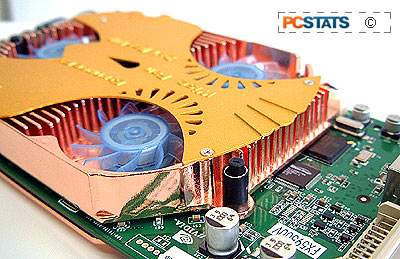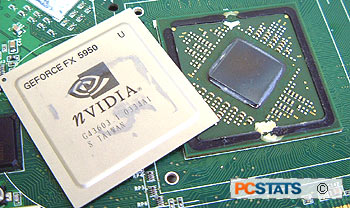
|
The FX5900 Ultra gave the Radeon 9800 Pro a good run for its money, but the question we are now facing is if the revised FX5950 Ultra be able to dethrone the Radeon 9800XT?
82% Rating: 
|
|
|
|
Home >
Reviews >
Video Cards >
Albatron FX5950UV |
|
|
Quiet Cooling System
Unlike other Albatron videocards, the GeForceFX
5950 UV uses a green (not blue) coloured PCB. The card is fairly long, and
heavy with the large heatsinks too. All high end videocards require extra power
but I would have preferred Albatron to orient the molex power connector parallel
to the PCB - it just makes it a little easer when installing the power cord.
 Albatron equip the FX5950UV with
the "Wise Fan HSF" which we saw on their FX 5900 PV a while back. Albatron equip the FX5950UV with
the "Wise Fan HSF" which we saw on their FX 5900 PV a while back.
Two of the three 40mm fans spin by default, however if one
fan should fail, or the temperature rises above 56 degrees Celsius, the
third backup fan will kick in automatically.
To test out the redundancy we stoppd one fan with our
finger and as expected the third fan spun to life almost immediately. For
those of you who are allergic to noise, you'll be happy to know that the
fans are very quiet and are impossible to hear inside an enclosed case. Oh, the center
of the heatsink lights up with a blue LED when the fan has power, it looks
pretty cool.
Albatron
also cools the BGA DRAM on the back and the rear of the GPU with large aluminum
heat spreader. Albatron uses a good amount of thermal paste between the chips
and the heatsink which should ensure good thermal transfer between the chips.
Surprisingly when we removed the Wisefan heatsink to grab a
snapshot of the core, the copper heat spreader protecting the FX GPU came
right off; this, without forcing the heatsink at all.  With the copper heat
spreader off we could view the the GeForceFX 5950 Ultra core in all its goodness.
Despite being built on 0.13 micron manufacturing, the core is still quite
large. The silicon is easily as big as the R3x0 core, and they're built on 0.15
micron. With the copper heat
spreader off we could view the the GeForceFX 5950 Ultra core in all its goodness.
Despite being built on 0.13 micron manufacturing, the core is still quite
large. The silicon is easily as big as the R3x0 core, and they're built on 0.15
micron.
With those
130 million transistors running at 475 MHz, the GeForceFX 5950 Ultra produces a
lot of heat and with nVIDIA's built in thermal monitoring software we noticed
the chip was idling in Windows at around 45-50 degrees Celsius. Under load we
saw temperatures above 70 degrees and that will create a huge hot spot in any
PC.
Because the
GeForceFX 5950 Ultra is basically an higher clocked GeForceFX 5900/5900 Ultra if
you'd like to learn a bit more on its underlying technology please read our Albatron GeForceFX 5900PV
Review.
We've said
this before and we'll
say it again, overclocking nVIDIA based videocards is now harder because of the
built in thermal management feature. It's certainly not a bad feature and I'm
glad nVIDIA has incorporated that into their graphics processors, but it does make
things a bit more difficult for the enthusiast.
|
